Reptile & Amphibian
News Blog
Keep up with news and features of interest to the reptile and amphibian community on the kingsnake.com blog. We cover breaking stories from the mainstream and scientific media, user-submitted photos and videos, and feature articles and photos by Jeff Barringer, Richard Bartlett, and other herpetologists and herpetoculturists.
Monday, June 10 2024

Note the yellow temporal line on this adult Chinese Box Turtle
At this point in time it has become difficult and quite expensive for hobbyists to acquire Asian herps, turtles included. Even prior to importation difficulties, hatchlings of several turtle species in the genera Cuora and Cistoclemmys were being priced by breeders in the many hundreds and even thousands of dollars each. Today (2024) the prices of many taxa are even higher.
Fortunately though, a few of the species that can still be imported and/or that are easily bred remain almost affordable. One of these, long a favorite of hobbyists (me included) is Cuora flavomarginata and is known to most as the Chinese Box Turtle. The 3 subspecies are divided between China mainland, Taiwan, and Japan. The subspecies, all remarkably similar in external appearances, are C.f. flavomarginata from Taiwan, C.f. sinensis from southern mainland China and C. f. evelynae from Japan.
Like the American Box Turtles its carapace is highly domed and the turtle has a very functional plastral hinge. The carapace may vary in color from dirty olive to black, with the latter being the more common. There is a yellowish vertebral stripe and the marginal scutes are a combination of dark and light pigment. The skin atop the head and on the limbs and tail is a dark charcoal, occasionally with pale olive overtones, The crown is separated from the pinkish cheeks by a prominent yellow bar on each side. All colors are at their brightest when the turtle is in breeding condition. Both males and females attain a straight measure of 5” (rarely to 6”).The external differences between male and female C. flavomarginata are slight. Males have a broader (but not much longer) tail than females. When extended the male’s tail is almost triangular in shape.
Like many terrestrial turtle species, the Chinese Box Turtle is omnivorous. Moistened tortoise diet, canned pet food, fresh succulent fruit, insects and worms are all accepted eagerly by most captives.
Summarizing, the common name given this turtle is quite descriptive, although not brightly colored they are pretty, personable, longlived, and proving that they are easily kept, some of mine have been captive for 40+ years.
Continue reading "Thoughts on the Chinese Box Turtle"
Monday, June 3 2024

This is the seldom seen Indian Eyed Turtle. Note the dark smudges on the bridge plates.
Morenia petersi, the Indian Eyed Turtle, a Geoemydid species, was once available to American hobbyists, but this seems no longer the case.
Like its very closely related Burmese relative, M. ocellata, it is also known as the Swamp Turtle. It seems at home both in and out of the water. Adult size for females is about 8 inches. The smaller males are adult at 4 to 5 ½ inches.
Diet is said to consist of both plants and carrion.
This interesting but rather poorly known turtle has a black carapace with a light ocellus on each plate including the vertebrals, a yellow-orange plastron, and a black head with 3 yellow facial stripes on each cheek. The yellowish bridge plates bear darker smudges.
Wild females nest about half way through the dry season. Each clutch consists of 5 to 9 eggs. Incubation seems to be about 70 days..
M. petersi is found in northeastern India and in Bangladesh.
Continue reading "The Indian Eyed Turtle"
Monday, May 27 2024

Southern Chorus Frog, once abundant but now seemingly less so.
Well, it was not really spring but 22 February 2024 was a fairly decent northcentral Florida day. The high had been about 73F and the low was forecast about 10 degrees cooler. Not bad. But then I remembered that the herping spot I was thinking about was about 100 mile further north, so I subtracted 3 or 4 degrees, thought for a minute or two, and decided, what the heck. I was tired of sitting home, so I washed the car’s windshield, and headed northward beneath a sky filled overhead with skudding clouds, and looking ahead into a horizon of gray. Ten miles up the road it clouded up a bit more, sprinkled for a couple of miles and then as I drove on the rains came. In a flash the car had me amidst a literal downpour. It rained and rained some more. But no herps, not even the rain-loving amphibians seemed to be moving..
After a pass or two on the tried and true (and now failing) roadway I decided to head towards home. A couple of miles south I ran out of the downpour. Here the rain was barely falling, and whoops—frogsong—Southern Chorus Frogs, Pseudacris nigrita, from the roadside. The car, or I, had been well trained. No cars behind, onto the grassy roadside, stop, grab flashlight and camera, and I was heading for frogsong from the newly freshened roadside ditch.
What had been an uneventful night soon became a joyful one for the chorus frogs were not the only species calling. Before midnight I had added spring peepers, Pseudacris crucifer, and even a few unexpected warmer weather (=springtime) species-, green and squirrel treefrogs, Hyla cinerea & H. squirella, a few southern toads, Bufo ( Anaxyrus) terrestris and oak toads, B (A) quercicus, among them. And although they were not chorusing, Southern Leopard Frogs, Rana utricularia, were out and very active.
Ahhhhh, Florida and spring in Midwinter. Always good to experience.
Continue reading "Ahhhhhh, Spring"
Monday, May 20 2024

Young adult Barbour's Map Turtle
Back around 1960-something or the other, Patti and I used to take roadtrips much more frequently than we do today. As I think back, that was understandable because so much, including the various herps, was new to us. So we meandered from one end of the state to the other, and then westward to the 3rd end of the state, the Panhandle that reaches from Madison to Escambia counties. Somewhere along these craggy lines I began photographing again with the goal of depicting each and every amphibian and reptile that called Florida home. And and with that fixed firmly in mind, a beautiful dimorphic aquatic Panhandle turtle.caught my eye.
This was and is Barbour’s Map Turtle. It took only a few minutes research to learn that to do photographic justice to this persistently aquatic turtle would require pics being taken of 3 stages in its life, a hatchling, an adult male, diminutive though these may be, and a hulking adult female that, when fully grown is more than twice the size of the males. To apply a measurement to carapace sizes, hatchlings are about 1 ½ inches, adult males are about 4 ½ inches, and adult females are about 12 inches, impressively notable differences.
To shorten an unwieldy tale, hatchlings and males were easily photographed. It took only a couple of slow and enjoyable canoe rides, stopping here and there at submerged or protruding snags to take the “needed” pix. But the adult females were another several stories. Over the years Patti and I tried and failed. 4 decades rolled on by. 20 years ago Carl May and I tried. Again, failure. Now here we are in 2024 and I’m going to try again—this time with Jake..
And, because of unexpected flooding we almost failed again. But at the last stop Jake came through. He spotted a single female, way downriver, clambered down an 8 foot vertical drop, and took pix for both him and me-----and you. .Thanks, Jake.
Continue reading "Barbour’s Map Turtle"
Monday, May 13 2024

Typical eastern (chain) kingsnake from the FL-GA state line.
Well, firstly, if you are inclined to listen to the geneticists, the Florida Kingsnake, Lampropeltis getula floridana has become a nonentity, a snake having no special or interesting qualities. And that same disregard for subspecies would apply to the phases we have long known as “ brooksi” and “ goini.”. So for our purposes, herewith we’ll disregard the genetic findings and mention the various getula kingsnakes in FL as subspecies, as Linnaeus meant them to be.
In one subspecies or another the Kingsnake complex ranges throughout Florida
From the FL Keys in Monroe County, to the St Mary’s River in Nassau County, Fl and then westward to the Escambia River in Escambia County—In other words throughout all of FL---you will be treking through “Kingsnake Country”. These big, beautiful, secretive snakes are, or at least once were, found from border to border to border (and far beyond) in the sunshiney state of FL.
the USA.From the FL Keys to GA and AL a Kingsnake of some color could be encountered.Not only are these Found in one or another color beautiful snakes
When adult the various subspecies of the Eastern Kingsnake, including the nominate form, are big, occasionally attaining or even exceeding by a few inches, 6 feet in length. The base color may vary from yellow or black in northern FL to brown or yellow in southern FL.In northern FL the yellow occurs primarily in 2 discrete areas—Apalachicola Natl Forest and coastal neFL. A darker narrow vertebral stripe may or may not be present. They are rare in the former area and have not been seen for many years in the latter region.
Most individuals seen from north of the Ocala, FL area and except for Apalachicola area have been of rather typical eastern (Eastern Chain Kingsnake) pattern. The keywords in that sentence are “rather typical.” The differences usually most visible are in the variable amount of white—the thickness of the white bands both dorsally and laterally.Kingsnakes from the Panhandle , except fo the Apalachicola area, are white chain-patterned black snakes.
Florida Kingsnake pattern and colors are usually lighter overall than other subspecies, but some have a truly bungled light pattern over the black, or vice versa. Look for these from Ocala southward on the peninsula to Miami..
South Florida or Brook’s phase: Most King Snake enthusiast have searched eagerly for this Kingsnake having greenish ground color near Andytown—what? You don’t remember Andytown? No wonder. It was swallowed decades ago by the Interstate Highway System!—and more of a golden yellow down Everglades National Park way. Although variable both in ground color and the amount of dark patterning, all are well worth the search to find your choice.
Appalachicola or Goin’s phase may be virtually patternless ot have large often elongate oval darker dorsal pattern. Although variable they are often quite similar to Brook’s King variant from southwestern FL.
Ahhhhh. Florida! The land of the Kings.
Continue reading "The Kingsnakes of Florida"
Monday, May 6 2024

This is a typical, but rather dark Ground Skink, also known as Brown-backed Skink.
Ground Skink, Scincella lateralis. This tiny, slender (adult at 3 ½ inches including tail) and occasionally to as much as 5 inches) ranges southward from central eastern NJ to the southernmost of the FL Keys and westward to western TX. It was common in yards, open woodlands, grassy lake and pond edges, where in the latter it does not hesitate to take shelter if frightened. Likewise, it can climb agilely but seldom chooses to do so.
At no stage in its life is this species colorful. The 1 ½ inch long hatchlings are of some shades of brown from nose to tailtip. Adults are also some shade of brown, have a dark, and usually well defined, dorsolateral stripe on each side, are lightest dorsally and laterally, and have a cream to yellowish belly. The species has a smooth, transparent spectacle in each lower eyelid, allowing vision even when the eye is closed.
At one time, this skink was easily found and observed throughout its extensive range. Perhaps in some regions this is still the case. Until 6 years ago they were abundant in our north central FL yard. Today (March 2024) marks the 5th year I have seen none. I’ve flipped cardboard, both damp and dry, rolled long-fallen logs, turned plywood and roofing tins, looked by day, dusk, and nighttime, but no Ground Skinks were to be seen.
A few afternoons ago, on an 85F afternoon,100 miles north of home, I was so excited to see a ground skink crossing the pavement I almost went facedown exiting the car to photograph it
Now this tiny lizard assuredly belongs on the “Why Are The Herps Disappearing” list.
Continue reading "The Ground Skink, Scincella lateralis"
Monday, April 29 2024

This is a prettily colored albino Giant Asian Pond Turtle
The times?
They have changed.
And they have changed BIG time.
Herp species that used to cost $10 or $20 are now priced in the hundreds or even the thousands of dollars if they are available at all.
Why, you may ask have prices changes so radically? Two major reasons are species population control by origin countries and a stricter adherence to International Wildlife Laws by our US Fish and Wildlife Svc.
Compare these hurdles to yesteryear when the collecting, importation and exportation of many (if not most) herp species were basically unregulated.
An example would be one of my very favorite Asian turtle species, the Giant Asian Pond Turtle, Heosemys grandis Before the turn of the century Thailand (Bangkok was a MAJOR collecting, clearance and shipping center) the sales and shipping of this turtle species were basically unregulated. Young examples, meaning those in the 4 to 6 inch shell length range, arrived at USA dealers on almost every shipment. The price for those of normal color was in the $50, range (albinos, of course, were more expensive). If you want a normal color morph today (2024) start saving . At this writing, no young ones seem available but several 15+ inch long adults are being offered at $950 each.
Capable of living in water or on land the Giant Asian Pond Turtle may be found along bodies of water such as lakes, ponds, rivers, streams, and canals. It is omnivorous and finds food in both aquatic and terrestrial environments. Their diet consists of worms, larvae, insects, snails, carrion, and aquatic and terrestrial plants. Hungry captives do not hesitate to dine on turtle companions. Similar to other species of turtles, the giant Asian pond turtle has developed adaptations and different techniques for capturing prey in both types of environments.
A bit more about this impressive species: This turtle species attains a full size of 17” straight measure. In nature it inhabits waterways as diverse as rivers and streams to swamps, marshes, and rice paddies.
The dark carapace may be brown or black, the yellow plastron is heavily streaked with radiating dark lines. The jaws are powerful and in closing I’ll simply say “although they seldom go out of their way to bite, watch where you place your fingers”.
Continue reading "Asian Giant Pond Turtle, Heosemys grandis"
Monday, April 15 2024

All 3 photos are of this beautiful East African taxon. Why, a lizard of course. In fact, the lizard taxon of which I’m thinking has derived its common name from these features. Now identified scientifically as Gastropholis prasina, it is commonly referred to as the Green Keel-bellied Lizard.
The genus name, Gastropholis, refers to the belly and prasina, the species name refers to the green coloration.
Family: Lacertidae; Wall and Jewel Lizards.
Color: Basically a vibrant green except for rear of legs that is blue-gray. Often has a bluish tinge on lips and throat. If frightened/insecure the overall color may fade to a duller green. Females may be a bit paler than the males.
Lizard Size: A relatively slender 12 to 16+ inches of which 70% is the weakly, but effectively, prehensile tail. The digits are long, slender, visibly jointed, and ideal for an arboreal existence.
Scalation: Scales keeled and finely granular dorsally. Lateral scales are smallest in the upper rows but increase in size as they descend and meet the 6 longitudinal rows of visibly keeled belly (ventral) larger and visibly keeled.ventral ing-Disposition: Males (and occasional females) are agonistic to others of the same sex.
Preferred Temperatures and activity period:Diurnal; 75-85F (24-30C)
Terrarium Size/Type suggested: Upright format at least 30 and preferably 40 gallon size, planted, humid forest with sturdy climbing limbs.
Natural History: Coastal area of Tanzania and Kenya. An arboreal lizard of variable forested conditions, trees and shrubs.
Comments: Of the 4 species in this genus, three, G. tropidopholis, G. vittata, and G. prasina, are green in color and arboreal. The 4th taxon G. vittata,is basically terrestrial and buff-striped brown in color..Ventral scales are strongly keeled. Only one, G. prasina, is currently (Feb. 2024) available in the American pet industry.
Much has been learned about the natural history of this lizard from both captive breeders and field observers. Notes from the field observers, published in “A Field Guide to the Reptiles of East Africa (written by Stephen Spawls Robert Drewer, Kim Howell and James Ashe) informs us of the arboreal tendencies of prasina in the coastal woodlands, but mentions also that examples have been found in terrestrial locations. Eggs have been found both in damp tree hollows and in terraria. One clutch numbered 5 eggs and incubation duration was 61 days at 79F.
Continue reading "What’s Green, Slender, and Has Keeled Belly Scales?"
Monday, April 8 2024
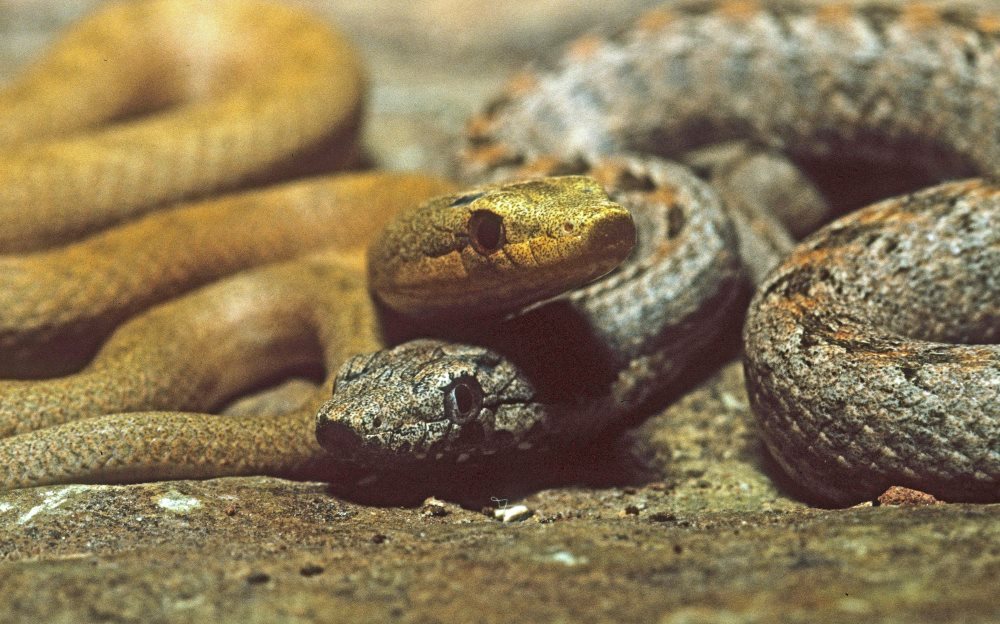
Hispaniolan Cat-eyed Snakes occur in many colors and patterns.
I’m revisiting this species hoping that somewhere in the world, someone has a breeding pair and will offer additional information on this Hispaniolan beauty.
Hypsirhyncus ferox, the Hispaniolan Cat-eyed or Hog-nosed Snake, is an interesting little dipsadine species about which very little is written. It is occasionally called the Haitian Hog-nosed Racer. All common names are well deserved, this snake having elliptical pupils, a flattened slightly upturned rostrum, and quickly and agilely fleeing any undue disturbances.
This little snake occurs in several colors that vary from dark gray to red with various browns and pinks between the 2. The snake may lack dorsal and lateral patterning or be heavily patterned, often moreso dorsally than laterally, but may also have light or dark lateral striping.
Long a single species found in both Hispaniolan countries and having 3 subspecies, recently it has been revisited by geneticists and (surprise, surprise!) has now been split into 2 species, one of which has 2 ssp. Adult size is about 15 inches and prey includes lizards and frogs. Cat-eyed Snakes can move agilely and quickly, rapidly disappearing when disturbed, escaping into or benearh underbrush or other readily available cover.
Over the years I have maintained a few as captive and found them to be secretive but hardy, readily feeding on anoles. Other than the fact that this is an oviparous snake, little is known about its breeding methodology.
This snake was not often offered even in the heyday of herp importing. Should you see them offered today and choose to have a small, easily maintained oddity, act quickly. And please let me know if there are extras. I’m looking too.
Continue reading "Hispaniolan Cat-eyed or Hog-nosed Snake, revisited"
Monday, April 1 2024

Once seen, our attention immediately turned from birds to snakes.
We looked long and hard for this little Trope, Tropidophis maculatus, and when they were found is was entirely by accident. Accident or not, we were elated. Our tour leader, Dr. Luis Diaz, had taken us to a Conservation Area where he and we were welcomed by the caretaker. We were looking in particular for Cuban Grassfinches, and we were delighted to see two small flocks along a grassy, palm shaded, roadway.
Of course, lying beneath each palm were fair numbers of dead fronds that we simply could not walk by without turning. Smart move, that. Because beneath the fallen fronds were numbers of broken cinderblocks and many turnable,flat rocks and chunks of concrete.Together these all held a bit of moisture on the reddish earth, so several rocks were carefully turned and just as carefully replaced. Soon someone said “snake!”
So, within moments of arriving we had in hand one of our several target species, the Spotted Red Trope (old name, Dwarf Boa) that had found suitable temperatures and moisture beneath the debris. And we truly had lucked out, because under the fronds and beneath other rocks, we found several additional examples.
This is one of the smaller trope species,being fully adult at 12 to 15 inches in length. Most found by us were in the 8-10 inch range indicating this to be a good breeding site.
Great memories to share, of a species seldom seen except in its homeland.
Continue reading "Spotted Red Trope"
Monday, March 25 2024
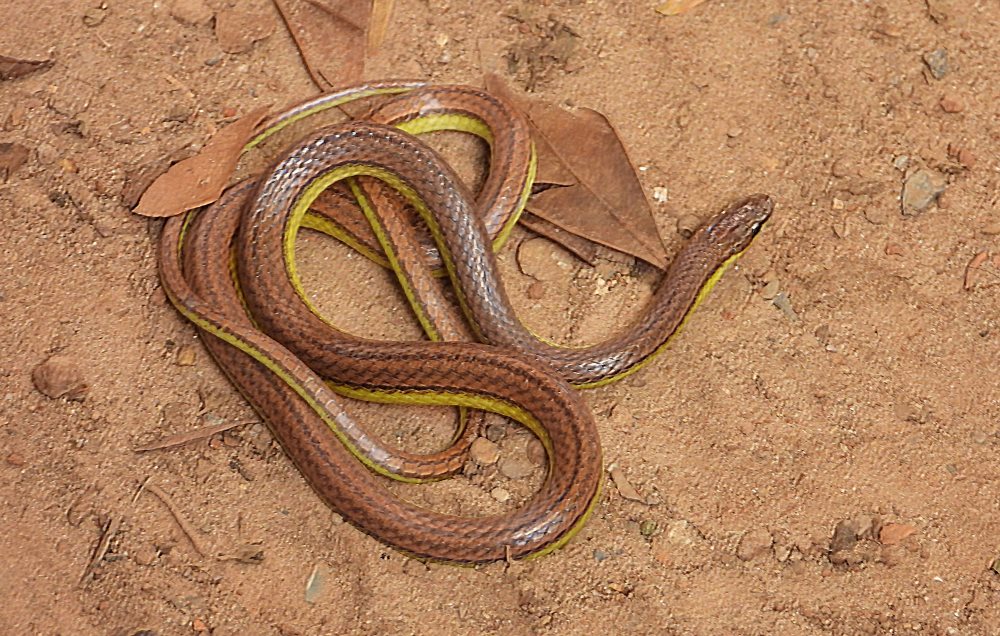
Arrhyton tanyplectum, Guaniguanico Racerlet
Small, slender, speedy, and quite secretive describes the appearance and habits of all members of this grouping. All, like the much larger Cuban Racer, Cubophis cantherigerus, are rear-fanged members of the family Dipsadidae. Those pictured here are of the genera Arrhyton, the Racerlets, and Caraiba, the Lesser Racer.. All are usually reluctant to bite, and of no danger to humans.
I make no attempt to identify or differentiate Arrhyton taxa herein, but merely mention some often overlapping generalities as to colors and patterns.
Dorsally and laterally, snakes of the genus Arrhyton are clad in shades of brown. The hues may varying from near-black to a light bronze or silvery-gray. The belly is yellowish. Depending on species, as well as on individual variations, vertebral and lateral stripes may be strongly present or absent. One species has a prominent whitish collar, another has a yellowish collar broken dorsally, and many have black or brown crowns.
The Cuban Lesser Racer, Caraiba andreae, on the other hand is a small but variably marked black and white snake (black above, white below) with a prominent light stripe from nose, to above each eye, and continuing to the back of the head. The labials (lip scales) are also white to cream. The result of these light stripes, of course, leaves a prominent dark stripe through each eye.
And now to the pix.
Continue reading "Racerlets and the Lesser Racer of Cuba"
Monday, March 11 2024
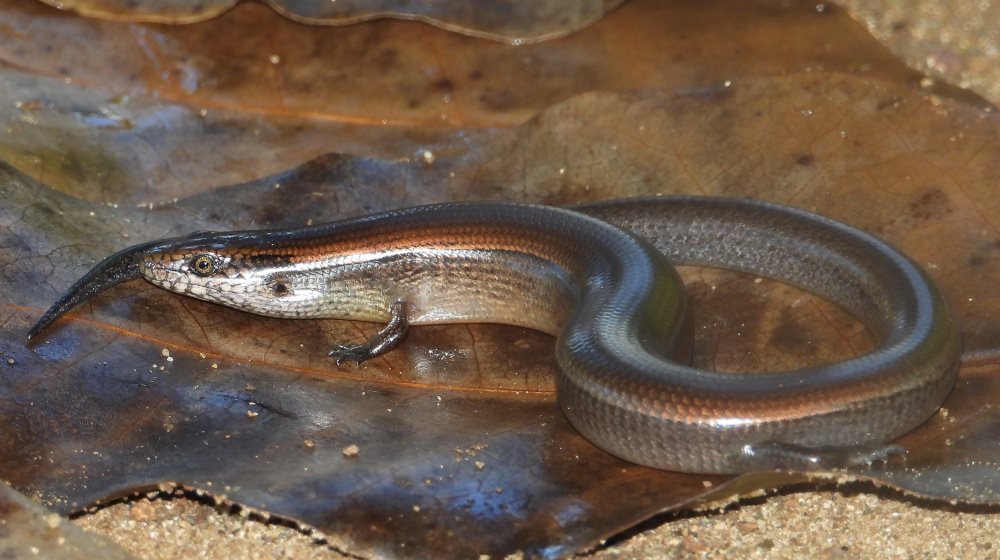
An adult male D. delasagra
In Cuba, the family Diploglossidae is represented by 3 species of secretive, fossorial, forest dwelling lizards of the genus Diploglossus, that look overall, very much like skinks. In fact, with their polished scales and narrow head, they were at one time classified as skinks. This species is known to hybridize with at least one, and possibly with both, other species in the genus at the eastern end of its large range.
Luckily, we found 1 species, D. delasagra. It, a small, shiny, and short, legged species, will writhe quickly beneath leaf litter if exposed. It also seeks shelter beneath rocks and fallen tree trunks and limbs.
It is adult at a length of about 9 inches, of which a bit more than half is tail length.
Dorsal color is a warm brown, the sides vary from chocolate brown to black. The belly is yellowish. Oviparous, one female found recently was coiled around 5 soft-shelled eggs. Hatchlings are colored like the adults.
Continue reading "Skinklike Forest Lizards"
Thursday, February 8 2024
 Alterna crew in Del Rio, Photo by Jeff Barringer -
Alterna crew in Del Rio, Photo by Jeff Barringer -
While looking for the photo of the day today, I came across this old gem. See kingsnake.com turns 25 today. I have heard the story many times of how Jeff tried to sell this whole website to people 25 plus years ago on herping trips and everyone thought he was crazy! See you have to realize the internet and the tech world we know it is new. We old fogies used to actually talk to people. I know! We would CALL people on the phone and we would answer phones not knowing who was calling! It was insanity! Forums lost their flair when social media hit because people liked that instant gratification. Our archives however is the history of our world. The who's who of the reptile community really and well worth the time to look back. We learned how to make things better back then and you can watch how the reptile community grew to where it is now. We were also closer.
This photo is the early days. Well before kingsnake.com started in West Texas the old Alterna crew days. Many of these people are still around, some aren't. How many can you recognize?
Monday, December 18 2023
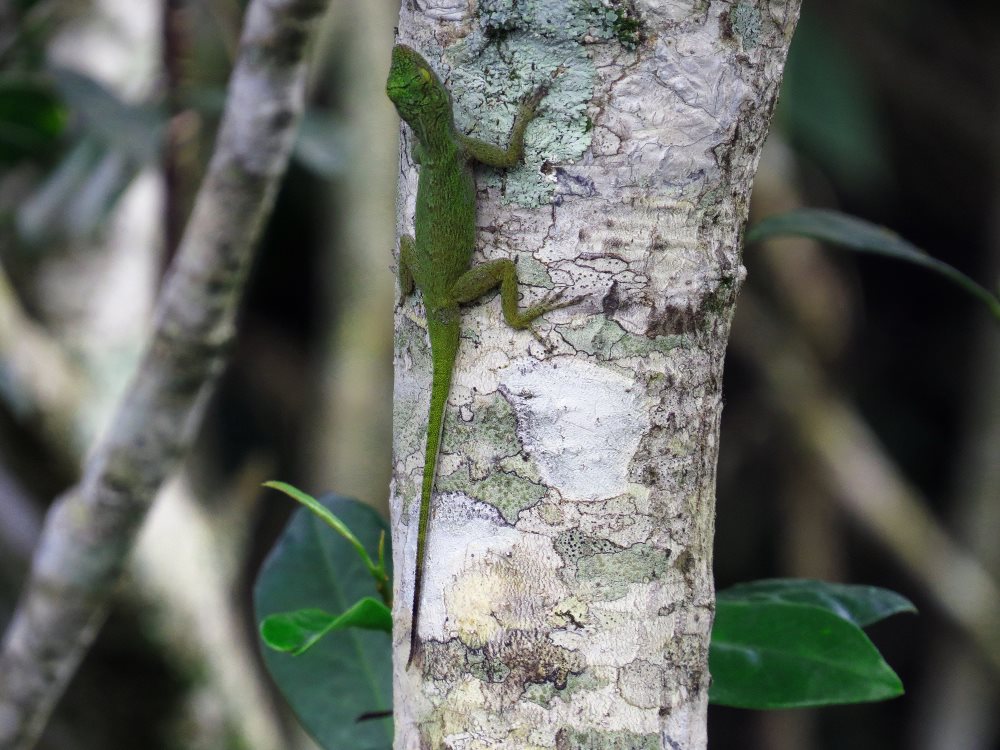
An Hispaniolan Bark Anole on the ascent in A Florida Hammock.
In some cases this variable species might be referred to as “that other Florida anole.”
It seems that no one is 100% certain how this Hispaniolan/Bahaman species reached Florida in 1946, but reach it, it did, perhaps as a whim of Mother Nature, but more likely the result of multiple whims by humans.
The species history of the Bark Anole, Anolis distichus, might be termed as “active.” At one point in time the Bark Anole was overloaded with 18 subspecies. But people seemed unable to decide if several of these were truly subspecies or were actually full species. Today nothing is definitive (so who is surprised?).
There are probably 2 subspecies of the Bark Anole in Florida. Except for overall color a single description fits both equally well.
There is the always some- shade- of- dark- banded- brown- or- gray A. d. floridana , and the often some- shade- of -green A. d. dominicensis.The throat fan of the males may vary individually from pale yellow to light orange. In all, the dark banding is straight and most prominent across the head from eyelid to eyelid and on the tail. Dorsal banding is in the form of narrow, often difficult to see, chevrons.
Both anole subspecies are arboreal, predominantly tree trunk/low limb, species.
Bark Anoles are one of the smaller species attaining an adult size of 4 to 5 inches of which a little more than half is tail length.
In Florida these little anoles are often found in colonies, are wary, and can be difficult to approach.
Ants and other small crawling insects seem to be the favored prey of this species.
Continue reading "Bark Anoles"
Monday, December 11 2023

Aquatic Anole, A. vermiculatusLet’s take a look at the anoles in general.
The Anoles are a huge grouping of small (Carolina Anole, Anolis carolinensis, 5 to 8 inches overall) to relatively large (Knight Anole sp., Anolis equestris 14-19 inches overall) sized New World lizards. Number-wise there are more than 275 (probably closer to 400) species.
Males are larger than females; males have dewlaps (throat fans), and both sexes have expanded toe pads. Most species are primarily arboreal, some dwell in canopy locations, others on lower twigs, many are at home on tree trunks, while a few are at least partially aquatic ( A. aquaticus & A. vermiculatus are examples of this latter).
Most are insectivorous, some add fruit to the daily diet. Cannibalism by large taxa on smaller is well documented. Color-changing ability of some have led to the vernacular of “American Chameleon.” In some cases the color changes from green to brown or yellowish, gray, or brown may be accomplished in only seconds. Many other taxa can only alter the intensity of their normal coloration, let’s say from light brown or tan to deep chocolate brown being the norm.
Of the huge species number (most reside in the West Indies, Central and South America) we have in the USA only one taxon, the green or Carolina Anole, that qualifies as a confirmed native. Some folks consider a second, a subspecies of the Bark Anole, A. distichus floridanus, as a second native form, but this remains questionable.
But given suitably warm temperatures, such as those normal in central and southern Florida, several exotic species (I list these below) have been introduced and become established. To date, the most successful of these exotics has been the Brown (often called the Cuban or Cuban Brown) Anole,
Anolis sagrei. This species is now seen, at least sparingly, from the Carolinas to Texas. Established in southern Florida:
Anolis allisoni, Cuban Blue-fronted Anole,
Anolis.callainus, Dominican Green Anole (hold on – there are two more species with this common name)
Anolis cristatellus,. Puerto Rican Crested Anole
Anolis coelestinus, commonly known as the Hispaniolan Green Anole
Anolis cybotes, Large-headed Anole (Hispaniola)
Anolis distichus, Bark Anoles (originally 3 subspecies)
Anolis equestris, Cuban Giant or Knight Anole
Anolis garmani Jamaican Giant Anole (FL population now greatly reduced in numbers by unusual dips in winter temperatures.
Anolis peynadoi, Dominican Green Anole (1 of 3 species also known as as “Hispaniolan Green Anole)
Anolis porcatus, Cuban Green Anole
Anolis sagrei, Cuban Brown Anole
Continue reading "Anoles"
Monday, December 4 2023
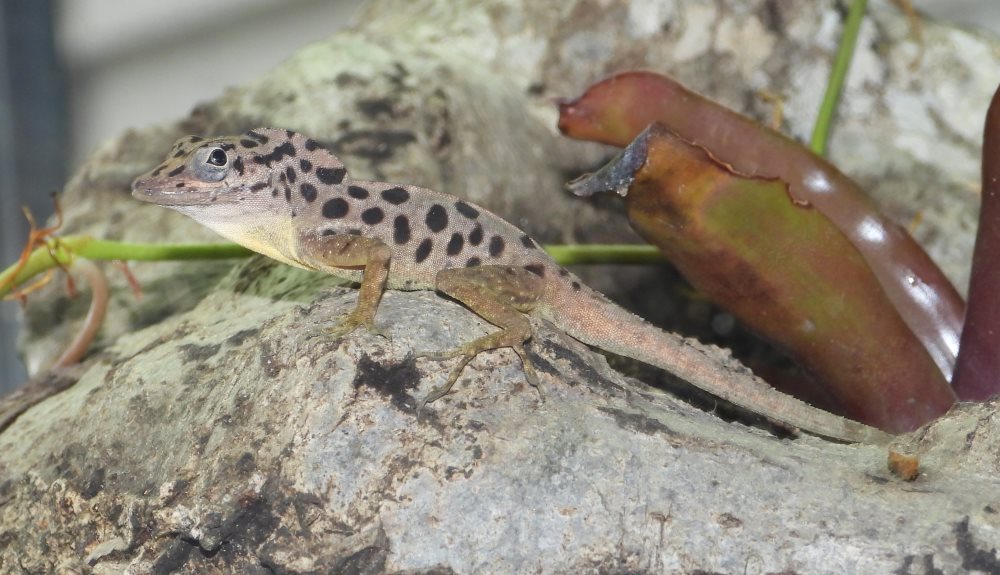
An adult male Saba Isle Anole. Anolis sabanus
Saba!
What is Saba?
Saba, it turns out, is a tiny upthrusting in the northeastern Caribbean. Only about 5 miles across, this tiny island has sandy beaches (expensive hotels), 4 main villages having descriptive names such as The Bottom (Saba's capital), Windwardside, St. John's and Zion's Hill (aka Hell's Gate), and even has some rainforest. Oh yes, it also has 3 indigenous and endemic reptiles, an anole, a Sphaerodactyline gecko and a Colubrine snake.
But initially it was only the anole that I found of interest. I had learned of this lizard through Jake, who had talked of both its homeland and beauty for months. In fact, Jake wanted to fly to this lizard’s dot of land to photograph it. But to me it seemed a long journey simply to photograph a single lizard species, and an anole at that.
Then Jake found an online pic and my attitude was swayed. I had just about made up my mind to opt into the “Jake’s Anole Expedition” when an online ad for that exact species popped up on my computer screen. Rather than take the trip. I bought a couple of the lizards…both gender. The live lizards that arrived were even prettier than the pix I had seen. The anoles are sexually dimorphic, the female lacking the polka-dots of the adult males.
Both the male and the female, seem to be doing well, eating tiny crickets and flightless fruit flies. Males have a beautiful, large, deep yellow throat fan. I hope you’ll agree that, although not one of the larger species, it is a species well worth looking at.
Continue reading "Saba and Its Anole"
Monday, November 27 2023
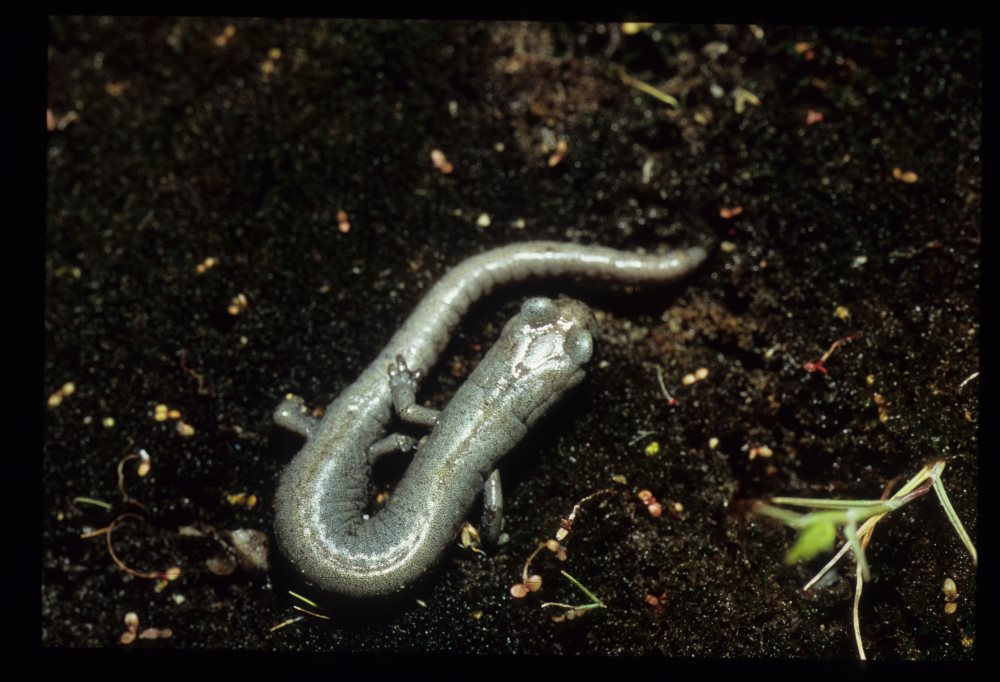
This adult Inyo Mountain was about 4" in total length.
I think I can move that boulder, Gary said. It’s the only thing I can see that’s blocking access.
I agreed with the 2nd of Gary’s statement, but the initial comment concerned me. It was a BIG boulder and neither Gary nor I were of boulder-moving stature. But move it he did, and we were again on our way along a tooth-loosening Jeep trail—and we were not in a Jeep.
It was an amphibian, a caudatan, that had brought us onto this sun-drenched trail. Around us stretched the peaks of the Inyo Mountains. Soon, no more boulders halting progression, we hoped this trail would swing a bit southward and then as it met with a tiny mountain stream, take us again eastward. And if we were then where we thought we actually should be, the stream would widen a bit, the moist banks would be surrounded by rock flakes, and beneath those flakes an interesting species of slender salamander, the Inyo Mountain Slender Salamander, Batrachoseps campi , was known to dwell.
As hoped for the Inyo Mountain Salamander we found was of the silvery phase. The presence of this salamander in an otherwise sere habitat proved the importance of even tiny trickles.
Guess what? Lady Luck was with us. We were right on target.
In a sudden turn the trail neared the trickle even more closely. The dried grasses gave way to tiny but beautiful orchids. And then the trail ended. We hopped out and carefully made our way to a stand of small shrubs interspersed with an occasional desert palm and sycamore. There the stream widened to a shallow 10 or 12 foot puddle, and along the banks were the rock shards we had hoped for.
As hoped, our careful search (of only a few minutes) turned up a salamander, one only, but this one was of the light phase. Photos were taken, the salamander replaced, and we left. A half hour later were back on the paved road, en route to another herp quest.
Continue reading "Inyo Mountain Salamander, "
Monday, September 25 2023
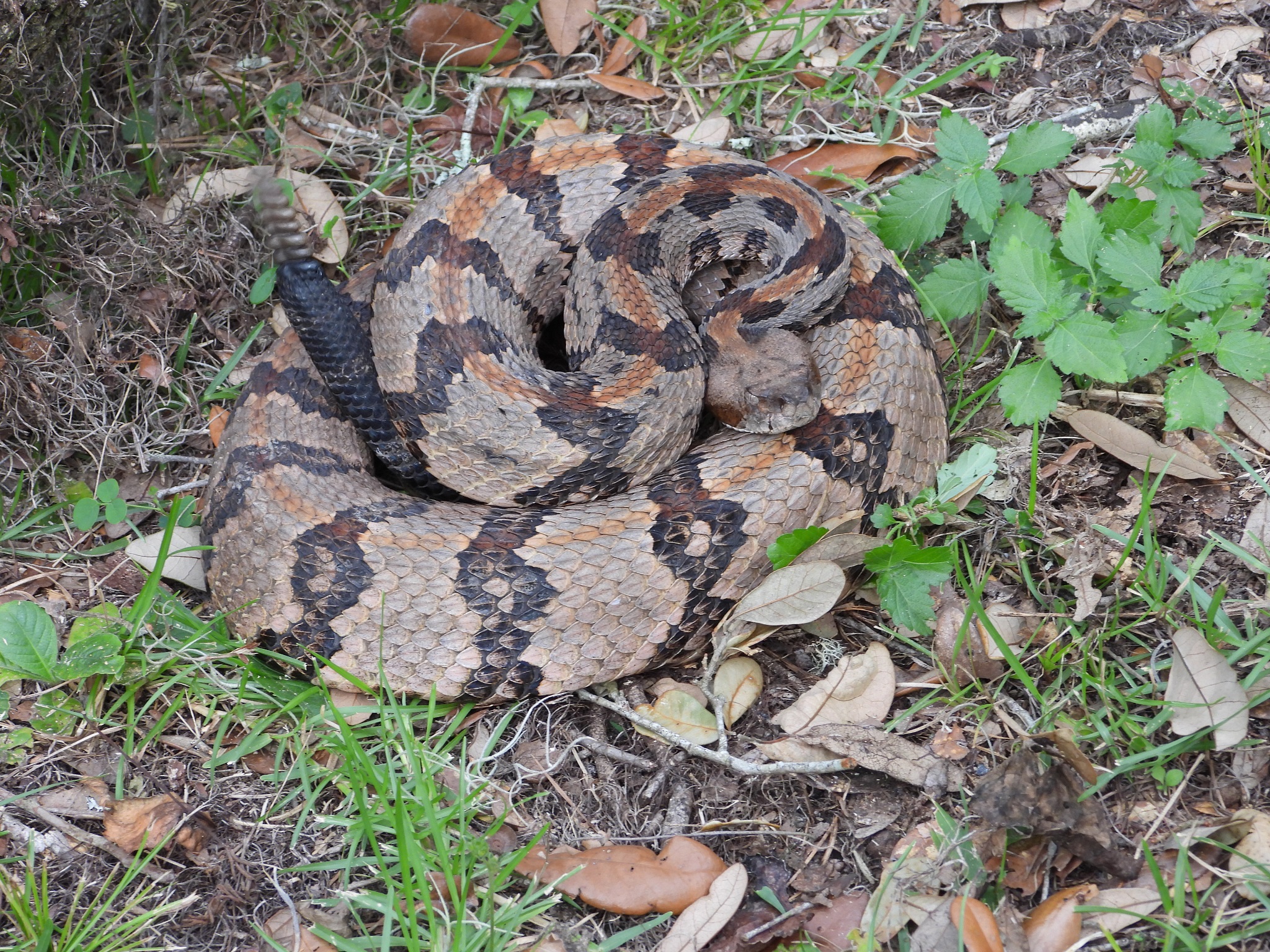
A Canebrake Rattlesnake, large and irate, but not without reason.
The sun was well below the horizon. Darkness was being ushered in by the plaintive calls of Chuck-Will’s-Widows and a few Green Treefrogs. The warmth of the day was giving way to what had been forecast to be a cool evening and an even cooler night. One more round on the herping road and time to head home.
But I only made it half-way and decided that enough was enough. I reversed and headed for home, still some hundred dark miles southward. Ahha. Pavement! Progress. MPH? Let’s say 60. A thick cover of clouds added to the darkness.
I swung around a curve and—SNAKE. Big Snake. It was in the opposite lane and was moving steadily towards the edge, the long roadside grasses and almost impenetrable woodland blackberry tangles.
I stood on the brakes, safely reversed direction—and the snake had disappeared. Was it a cottonmouth? I had been able to see it was very heavy-bodied. I clambered out of the car headlamp a blaze, clampstick in hand, and almost at woodland edge saw the tall grasses moving sinuously.
On my first step towards it I got snagged by blackberries, went down, and lost my headlamp that went out when it hit the ground. I floundered around, retrieved the dropped utensils, said the heck with this, stood up and stopped in my tracks. That big snake had decided to ”talk”, not in the hisses of an angry cottonmouth, but, rather, in the whirring language of an irate rattlesnake. And in this area it almost had to be a Canebrake, Crotalus horridus atricaudatus.
From that point on, all went well. I sidled towards the ratcheting, finally saw the coiled and irate snake, got a couple of dozen photos, and left after estimating the length of the snake as well over a hefty length of 4 feet. A bit darker in color than most seen in the area, it was the highlight of the night, and quite probably for the season.
Continue reading "CANEBRAKE! A Big One!"
Monday, July 24 2023
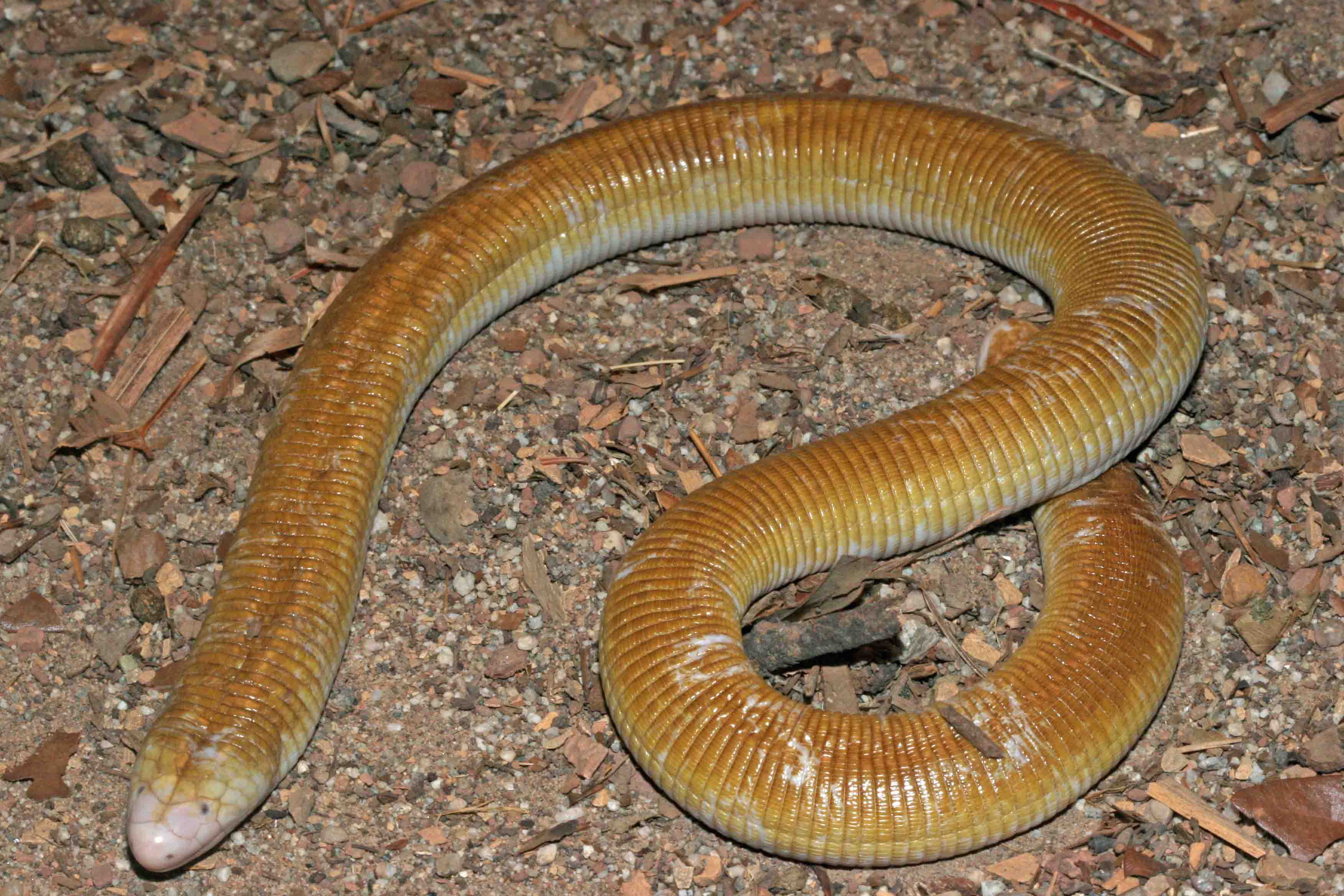
This almost all white example of the Giant Worm Lizard was found by a Peruvian villager.
Amphisbaenids are rather amazing creatures. In fact, they are so amazing that they are in their own family, the Amphisbaenidae. Most are legless, at least 3 species (in Mexico) have proportionately small, clawed, forelimbs but lack rear limbs. Amphisbaenids (often referred to as “worm lizards”) have for the most part, a, wedge-shaped head of the same width as their bodies that is adapted for digging, a cylindrical body, loose skin, scales arranged in rings, and a short tailt. Some species are long and slender, others, especially the European members of the family, are shorter and proportionately stout.
Despite perpetual but never confirmed tales of a Pacific Coast species, only a single taxon, the 14” long Florida Worm Lizard, Rhineura floridana, is known to occur in the USA. This, as suggested by both its common and species names, may be found in FL and extreme South Central Georgia.
The largest/longest amphisbaenid, is the 2 to 2 ½ foot long Giant Amphisbaenid, Amphisbaenia alba of South America where it ranges southward from Venezuela and Trinidad to Northern Argentina. It is also known as the Red (dorsal and lateral color) or the White-bellied (self-explanatory) Amphisbaenid.
In our dozens of trips to Amazonian Peru we had never seen one of these impressive creatures until one day a villager walked into the compound holding one that had been found near his home. Notable were the already mentioned colors, the darker eyespots, and the fact that while held it was not hesitant to attempt to bite.
Much in print information about this remarkable “worm lizard” is speculative. However, it is known that it is oviparous, laying ~12 eggs. It is also known that this burrower is often found in association with the nests of leaf-cutting ants. Stomach contents have disclosed that this species is primarily insectivorous, but also will eat nestling rodents and earthworms. One that I maintained was very fond of nightcrawlers. When defending itself the body is usually coiled in a semi-circle and both head and tail are turned upwards—but only the head, with widely opened jaws, need be watched (LOL)..
Continue reading "The Giant Worm Lizard (Amphisbaenid)"
Monday, July 17 2023
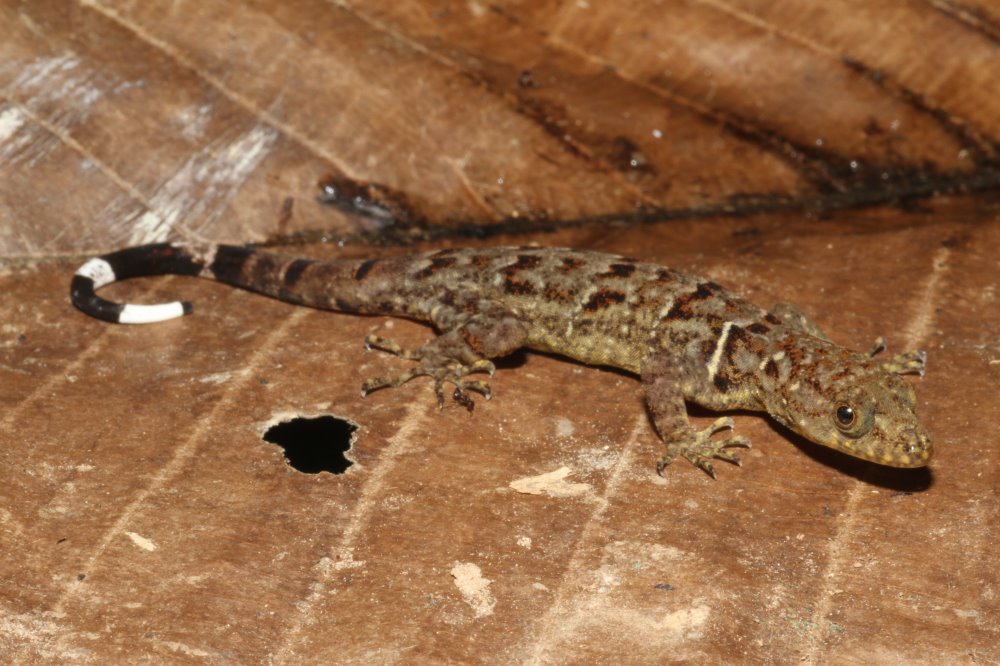
Female Collared Forest Geckos usually have prominently ringed tails.
This is another of the small but usually pretty geckos of the genus Gonatodes. The geckos of this genus are widespread in Tropical America as well as being present on many Caribbean Islands.
Although a bit less colorful than the related Bridled Forest Gecko, this Amazonian taxon, scientifically known as Gonatodes concinnatus, has derived its common name from the white to yellow bars on each side on the dark shoulders. It is the males that are so marked, the females having 6 or 7 chocolate and white transverse bars across the dorsum and usually also having white tail rings and tailtip. Males also have an unmarked brownish-yellow to orange head, shoulders, and forelimbs. Body ground color can vary. This species may be dark brown with faint lighter speckling or be exactly the opposite, being brownish-gold with dark speckling on the body.
Unlike its congener, the Collared Forest Gecko, this species seems seldom seen in camp clearings or on buildings, but is fairly common in the rainforest on stumps, fallen trees, and occasionally on broad shrub and tree leaves.
This is a small lizard, being about 3 ½ inches in total length. It is diurnal. A clutch consists of a single egg but several clutches may be produced annually.
Continue reading "The Collared Forest Gecko"
Monday, July 10 2023
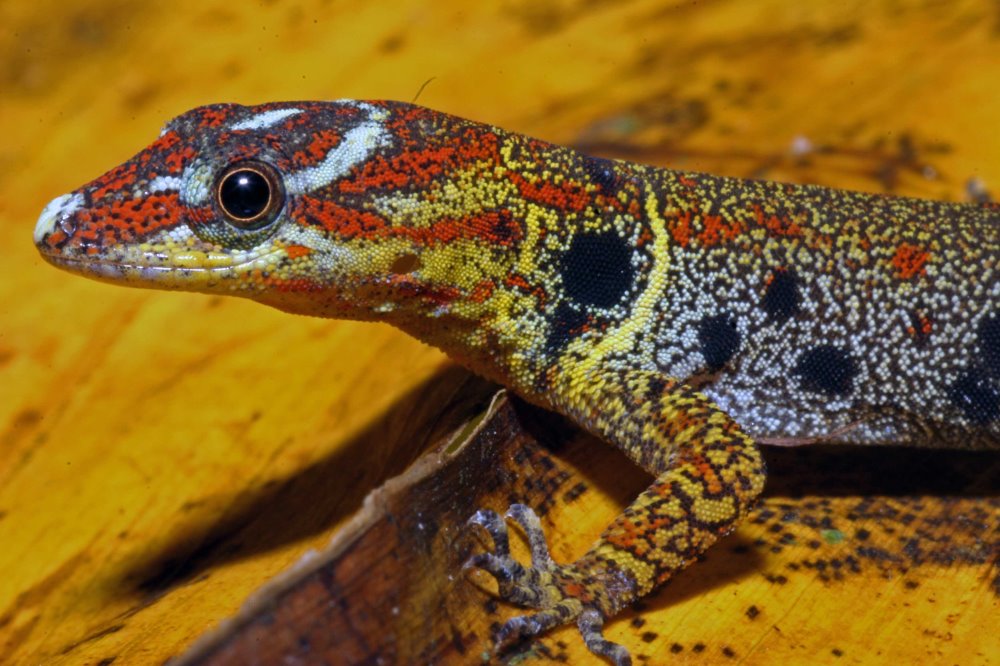
Although variable, male Bridled Forest Geckos are usually quite brilliantly colored.
It is often said that good things come in small packages, and this is certainly the case with the tiny geckos of the genus Gonatodes. Most are adult at an overall length of 3 ½ to 4 inches of which half is tail. IMO the little Amazonian species known as the Bridled Forest Gecko, G. humeralis, is a perfect example. I’ll admit that the females of all species in this genus are much less colorful than the males, and this is especially so when the males are in their breeding finery. The females are grayish with various darker markings and mottlings. Males, on the other hand, have an olive(ish) ground color dotted dorsally with pale to bright red and laterally with a mixture of black and reddish dots. Males also have a bridle-shaped marking of bluish-white as well as bluish-white markings atop the head, anterior to each eye and on the nosetip and yellow labial scales. These markings may all be pale when the lizard is quiet, but invariably brighten during courtship and actual breeding. A clutch consists of a single egg but several clutches may be produced annually.
Primarily diurnal, this little gecko is often seen on the buildings and plantings at Madre Selva Biological Preserve. It seems most common in clearings but is occasionally seen sleeping on broad-leafed plants in nearby rain-forest
As we move deeper into the rain-forest this species seems to be replaced by the Collared Forest Gecko, G. concinnatus.
Continue reading "The Bridled Forest Gecko"
Monday, July 3 2023

Large, gravid, and very dark in color, this Brown Water Snake was seen at canal edge in South Florida.The eastern USA is fortunate in having several species and subspecies of the genus Nerodia Water Snakes, as residents. Most are feisty if frightened, many will bite if carelessly restrained, and all are harmless (nonvenomous). Sadly, no matter how dissimilar they may look, many, if not most, are confused by those people who see them, with the venomous Cottonmouths. One that is most apt to be misidentified, is the Brown Watersnake, Nerodia taxispilota. It is also one that catches many folks by surprise.
The Brown Watersnake is one of the larger species, occasionally attaining 5 feet in length and being of heavy body. The color is variable, being brightest and most precise on neonates (yes, this is a live-bearing genus). Adults usually have a very visible pattern of light-edged dark dorsal blotches that alternate with light-edged lateral blotches. Some adults are very dark in overall color, especially when about to enter the shedding cycle.
Overall, the water snakes are semi-aquatic, but most are primarily water lovers. The Brown Water Snake, Nerodia taxispilota, may be seen basking in various riveredge situations including high in trees overhanging the water. From these perches, if startled, this big snake may drop into the water or, as too often happens, drop and land in the fishing boat that startled it. Sadly, when this happens this nonvenomous snake is often mistaken for the venomous cottonmouth and is summarily dispatched.
The light example seen here could probably be referred to as anerythristic (lacking red pigment)
Continue reading "The Brown Water Snake"
Monday, June 26 2023
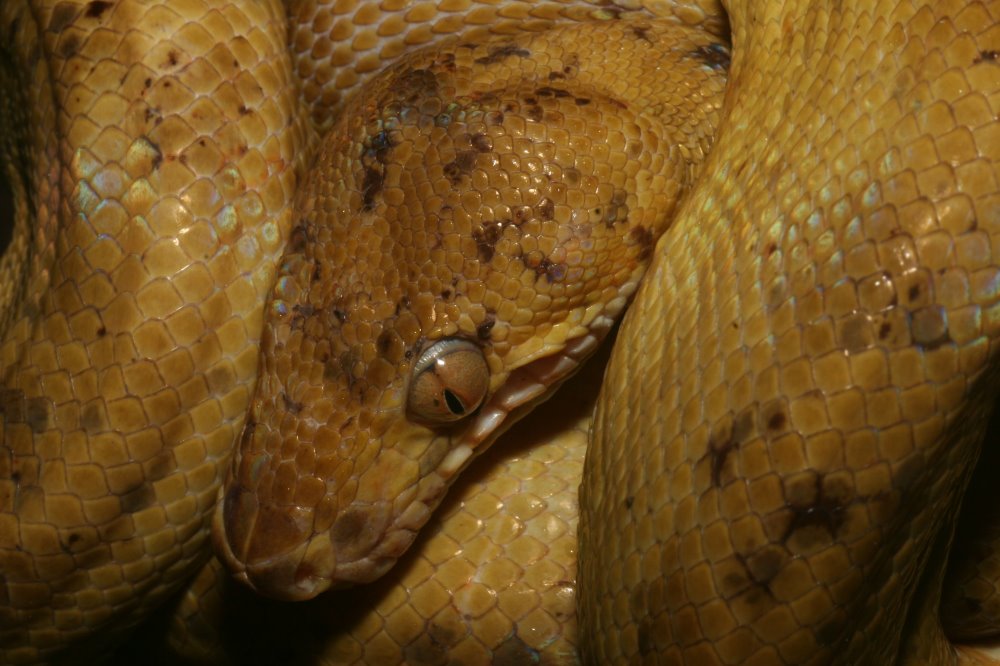
Yellow Amazon Tree boas were only occasionally seen on Madre Selva Preserve.
One of the first snake species that I saw at Madre Selva Biological Preserve was coiled high in the rafters of the old kitchen building. From my vantage point the snake appeared to be clad entirely in scales of “old rafter brown.” Tree Boa? Amazon Tree Boa? Could it really be? Could I be that lucky? Segundo, having been summoned, clambered up to the rafters, grasped the snake (that reacted in typical tree boa style) and was soundly bitten during his one-handed decent. He then handed the irate snake to me.
Since that first sighting, I’ve seen many Amazon Tree Boas, Corallus hortulanus, many of various shades of brown, some being brown and orange, other being yellow, and a few being a beautiful blood red. Some I caught, some Segundo caught, others by other of our guides. But somehow, somewhere during the photographing sessions, almost all of the snakes retaliated for having been disturbed and immortalized in a “toothsome” manner. Any of you who have kept these interesting boas will understand why I tell the participants on our herp tours, “Amazon Tree Boas just don’t play nice.”
But that has never dissuaded our tour groups or me from seeking the arboreal gems. Besides in the open-air buildings, we have found tree boas high in trees, others were dangling by their strongly prehensile tail, boa face at human face level, from vines that crisscross above our trails (if not noticed these could have resulted in a real “ouch encounter”). Others have been just coiled quietly atop stumps. On one trip, one of the dangling boas, a yellow example (pictured here) was seen on four of the six nights that we were at the preserve.
The tree boas found have varied in length from 18 inch juvies to 4 to 5 foot long adults.
Continue reading "Amazon Tree Boas"
Monday, June 19 2023

Broad-headed Skings were common in Okeetee. This male has assumed his seasonal breeding colors.
I don’t know how Gordy knew where we were but he did. The roadsign we had just passed informed us that Ridgeland was 20 miles ahead. And Ridgeland, in the state of South Carolina’s “Low Country,” was our goal.
This was way back in the mid-1950s and I was as “wound-up” as a young herper could be. I was an eager and avid herper, birder, and “everything-elser.” In other words, except for humans if it breathed, I wanted to learn about it, and herps were at the top of the list. And somewhere near Ridgeland there was a special place that Gordy had heard about---Okeetee Hunt Club. This was and is a 50,000 acre plot of land that came into being way back in 1894. Today it is fenced and patrolled and only members are allowed to enter. But back in the mid-1900s, back before today’s market hunters and the tendency to litigate every bruise or sprained ankle, anyone who wished could enter, and I was one of the lucky ones.
Besides being a refuge and gathering place for arms-bearing hunters, Okeetee was Mecca to a host of herpers. It was one of Karl Kauffeld’s favorite places and it quickly became one of Gordy’s and mine. And when you added on the several other nearby hunt clubs and preserves, the area became unbeatable. Corn snakes were common, as were Eastern Kingsnakes, Scarlet Kings, Hognoses, Eastern Diamondbacks and Canebrakes. Pine snakes were not uncommon; Broad-headed Skinks were abundant. Chorus Frogs ratcheted from nearby canal edges, Bird-voiced, Cope’s Gray, Barking and Green Treefrogs called from the Great Swamp. Oh, and did I mention that we often found Mud and Rainbow Snakes, and Red-bellied Water Snakes. The list goes on and on.
I’m glad that I actually got to experience those times now long gone. I wish the herpers of today, well.
Continue reading "Okeetee Memories"
Monday, June 12 2023
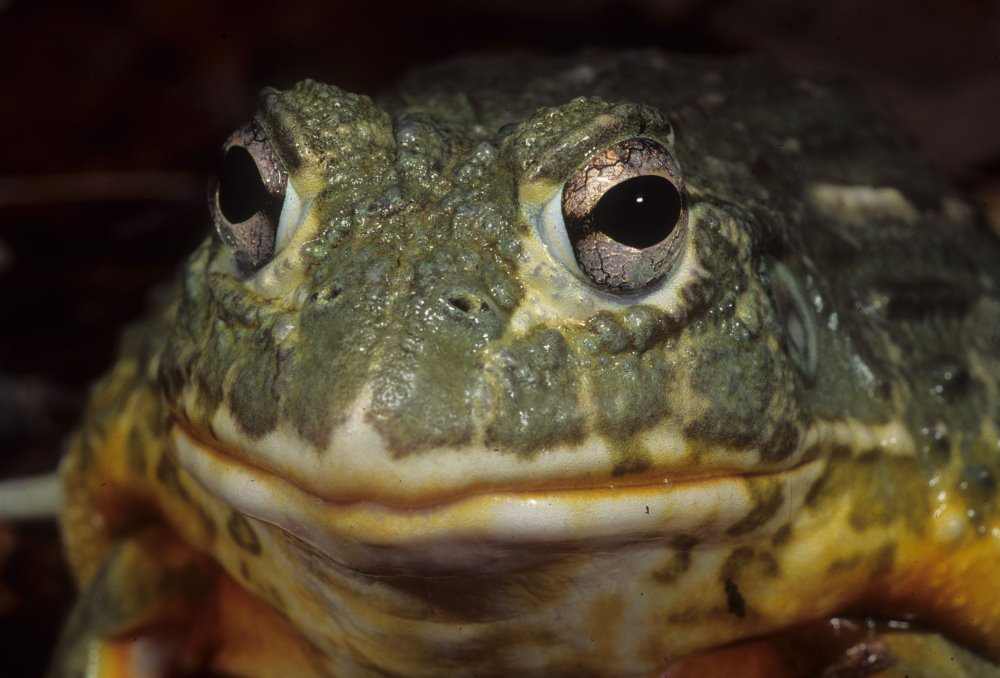
A young adult Pyxie Frog.Don’t be deceived by either the common or the scientific names. There is nothing—nothing at all --pyxie-ish about this frog. Adult males are every bit as large as the biggest of the Horned Frogs, Ceratophrys. They surpass in size the biggest American Bullfrog that I have seen, and are equally as voracious as any examples of either.
The frog we are discussing is the African Bullfrog Pyxicephalus adspersus. It is in the small family Pyxicephalidae. It has an immense range, including much of sub-Saharan Africa. The common name, of course, is derived from the genus name, and whoever decided on this scientific designation must have had a remarkable sense-of-humor. The Pyxie is cannibalistic, eats other frogs, rodents, and any invertebrates it happens across. Add to that the fact that it will latch rather painfully on to the errant finger of any careless keeper.
Possible lifespan is debatable. Some researchers say 20 years, others double that time span. It seems the frogs grow slowly, throughout much of their long lives. At adulthood male Pyxies may reach 10” in svl (snout-vent length). Females are smaller. Males are also a bit more brightly colored than the females. Males are a decided green and have a yellowish throat while the females are a much duller olive green to brown(ish)-green and have whitish throats. Juveniles are green with bright green vertebral and lateral stripes.Several rows of interrupted, elongate, dorsal and lateral ridges are present on both sexes.
Pyxies are secretive and spend much of their lives in burrows of their own construction. They are explosive breeders, emerging from their burrows to breed en-masse in temporary waterholes formed at the beginning of the rainy season. Sparring by the males is a common occurrence.
As an aside, hobbyists actually like this belligerent frog, and Pyxies are now being bred commercially for the pet trade.
Continue reading "Pyxie Frogs"
Monday, April 24 2023
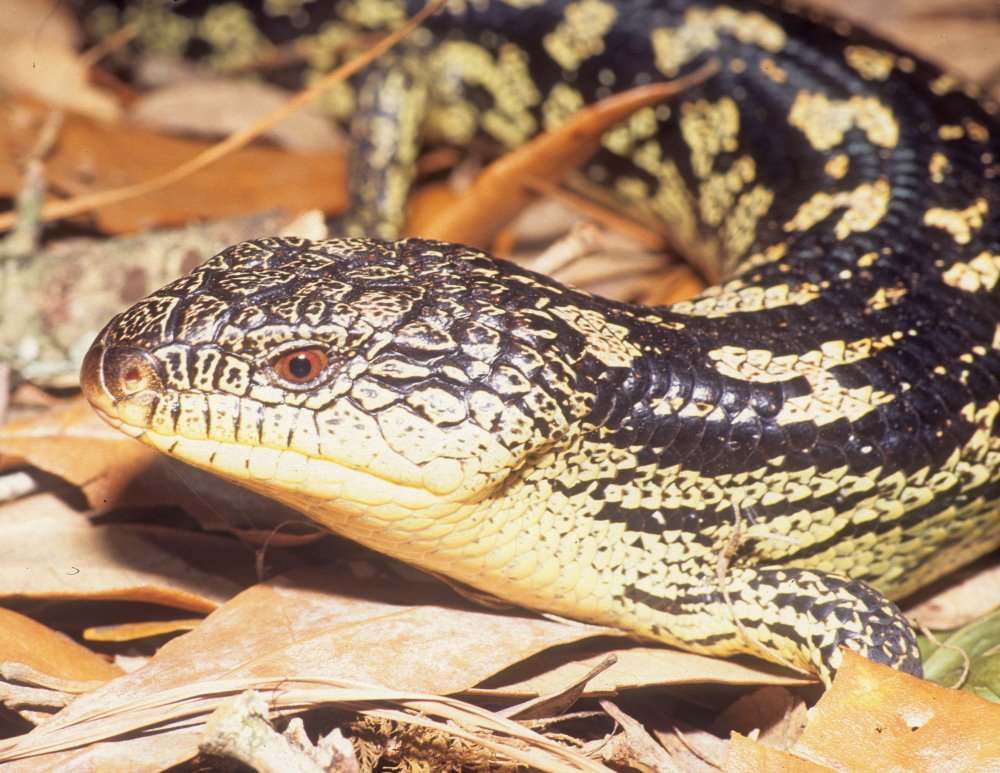
Not brightly colored, but IMO the finest of the Blue Tongues, Tiliqua nigrolutea.
Having well over 300 skink species, Australia could also be known as the “Great Land of Skinks.” These range in size from 4” long Garden Skinks and Pygmy Blue-Tongued Skinks to the remaining 5 species, all bulky blue-tongued species of the genus Tiliqua (one (possibly 2) additional species are extralimital). The Australian species are the Blotched, Common, Centralian, and Western Blue-tongues, and the Stump-tailed Skink, this latter now being considered one of the Blue-tongued skinks. These 5 vary individually within species from 16 to 23 inches in overall adult length.
Although we have kept several species, it is the Blotched Blue-tongue, Tiliqua nigrolutea, that is my favorite. Additionally, I favor the black (ground color) and buff (dorsal blotches and lateral reticulations) of the montane form over the paler colors of the lowland forms. Both forms are heavy-bodied, short-legged, diurnal, terrestrial, adult at 16-20”, live-bearing, long-lived (~20 years), placid, and hardy.
This skink adapts well to varying temperatures as well as eagerly accepting a wide variety of food items. Ours ate fruits, vegetables, canned dogfood, softened kibbled dog food, and they loved snails, slugs, and nightcrawlers. They often fold the hindlegs back towards the tail when moving about.
Females produced a single clutch annually, neonates numbering 3 to 8.
If you like responsive, hardy, captives, and if they are ever again legally available and affordable, consider a Blotched Blue-tongue. I don’t think you will be unhappy with the choice.
Continue reading "Blotched Blue-tongued Skinks"
Monday, April 17 2023
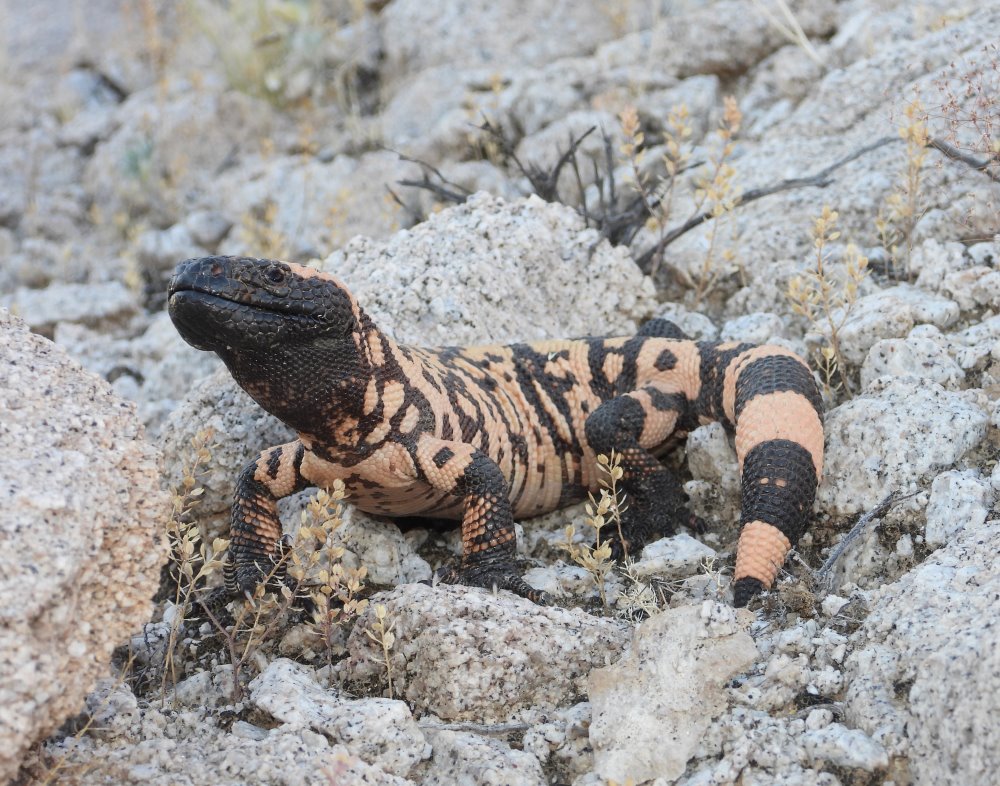
This beautiful subadult Banded Gila Monster was just perched along a rocky trail.
The Gila (pronounced Hee-laa) Monster, Heloderma suspectum, is famous for its venomous bite. It is the only venomous lizard in the USA.
I find them appealing both for their appearance and the fact that they are unpredictable in their appearances in areas as different as rocky deserts, mountain slopes, and heavily populated areas. I rarely find them when I’m looking for them. But when I’m not actively looking, I may stumble across one or two.
This is a long lived lizard. A life span of 20 to 30 years is often quoted, but one researcher has been observing and documenting the same Gila Monster in her (he has determined it to be a female) on her winter refuge for more than 40 years. That’s right, 40+ years for that matriarch!
To highlight their unpredictability, on a recent trip to California, Jake and I had failed to find the White rattlesnake we had hoped to photograph and were returning to the car along our different trails. Suddenly Jake gave a holler, saying “come look at this!”
I clambered over to where Jake stood, and there amid the rocks on the trail was a beautiful young adult Gila. And what made this even better than good, it was a Banded Gila, H. s. cinctum, the westernmore subspecies that neither of us had seen in the field before. Cameras were activated and the lizard was immortalized as it crawled slowly to the ground and out of sight.
Elsewhere and at another time a Reticulated Gila, H. s. suspectum, the easternmost subspecies caught our eyes as it crawled, well after darkness had shrouded the Arizona desertland, along a sandy roadside. More pix, happy smiles, and more herping ahead. Life was good.
About the Gila Monster:
Subspecies and Range:
Banded, H. s. cinctum, Western Arizona, Extreme Southwestern Utah, Extreme Southern Nevada, possible isolated pops in Southeastern California
Reticulated, H. s. suspectum, Central and Southern Arizona, Extreme Southwestern New Mexico, Central and Southeastern Sonora
Color/Markings: Usually pink(ish) with black bands or reticulations
Size: Adults 18-22”; Hatchlings ~6”.
Appearance: “Chunky,” short-legged, relatively slow-moving. Tail about half as long as head and body and of variable thickness (the tail is a fat storage organ). This lizard is not capable of autotomizing the tail. Scales beadlike.
Status: Often seen but protected.
Continue reading "Gila Monsters"
Tuesday, April 11 2023
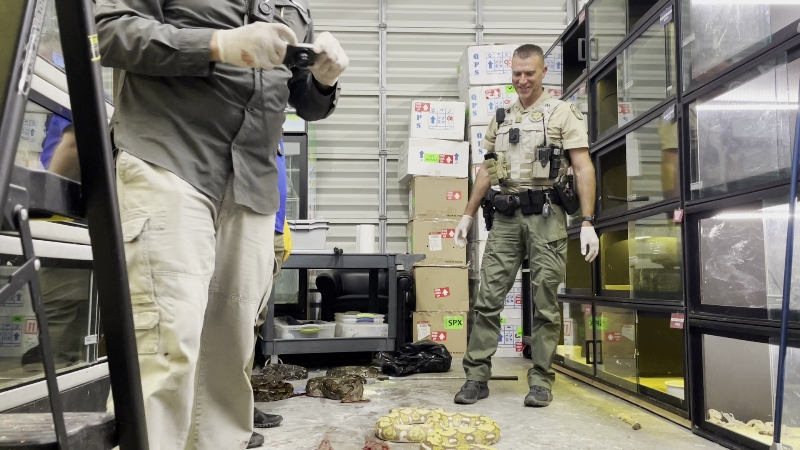 An FWC officer smiles as he surveys the scene after the killing of 34 pythons and a pregnant pet boa by FWC officers (Photo by Chris Coffee, who has granted permission for this photo to be published and disseminated)
An FWC officer smiles as he surveys the scene after the killing of 34 pythons and a pregnant pet boa by FWC officers (Photo by Chris Coffee, who has granted permission for this photo to be published and disseminated)
In 2021, Florida changed their ownership laws but promised that pet owners were able to keep their animals for the lifetime of the animals. Breeders stopped breeding and started moving animals out of fear of repercussions. Animals that were legally owned under a "Conditional Species Permit" were now considered illegal, however according to FWC, they were grandfathered in for the rest of their lives and could live out their lives in their current homes.
"I want to make sure the public's aware that if you currently own one of these reptiles, you're allowed to keep it until it's death. So no one is telling you you have to get rid of your pet or euthanize it and no one from the state is going to take it from you." Rodney Barreto , Chairman - Florida Fish and Wildlife Conservation Commission - Public commission meeting February 25, 2021
"Their pets are their pets and they are going to continue to be their pets and we made sure that it was very clear." - Mike Sole, Former Vice Chairman - Florida Fish and Wildlife Conservation Commission, Public commission meeting February 25, 2021
Continue reading "Holy Thursday Massacre: The Killing Fields of Florida"
Monday, April 10 2023
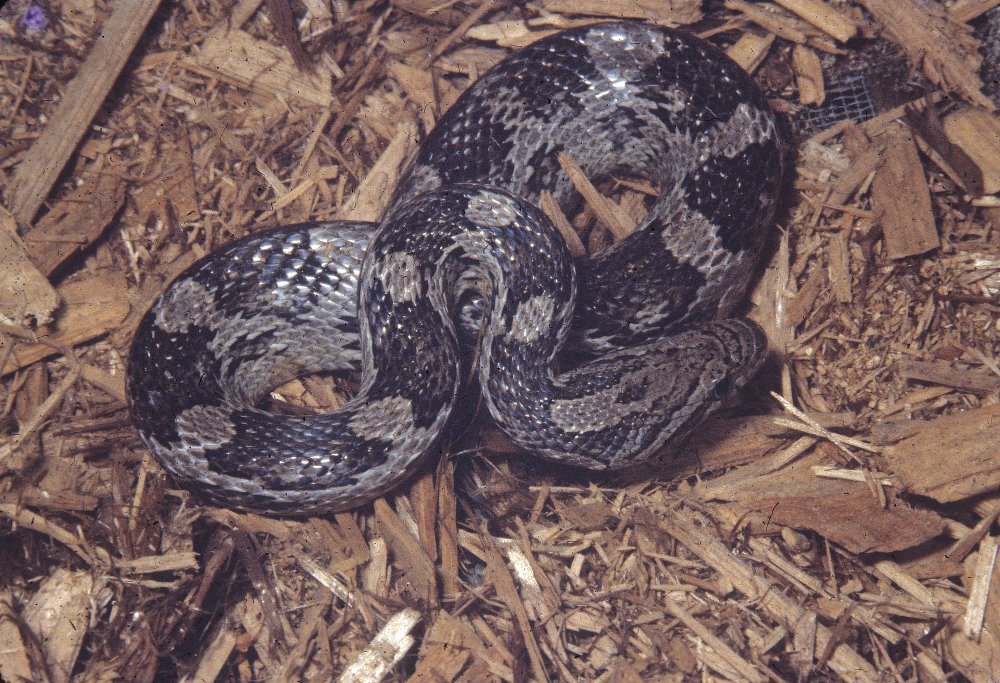
Even antheristic Corn Snakes very dark in color can be identified by the spearpoint on the top of the head.The Corn Snake, Pantherophis guttata, also known as the Red Rat Snake, is known to countless snake enthusiasts as a beautiful red, buff and yellow snake. Due to selective breeding in captivity, this species exceeds even the ball python in the variety of colors (and patterns).
But familiar though the hobbyists may be with the captive and normally red variations of this pretty constricting snake, many, many fewer realize that there are in the comparatively few wild areas left on the southern part of the Florida Peninsula, corn snakes of “a different color.”
Termed “anerythristic” (meaning lacking red), these snakes, pretty in their own modest way, have a variable ground color, gray with a brownish oversheen in most cases, to a pure dark gray on a few. Dorsal saddles and lateral blotches have brown centers with narrow to wide dark rimming. There is usually a dark edged, buff, postorbital bar present.
And while we’re discussing these, how did the name “Corn “ snake originate? It seems likely that this term describes the seemingly preferred habitat for this snake. It was and still is often found at the edges of agricultural (including corn) fields or in crop-storage barns.
Viva la Corn Snake!
Continue reading "Corns of a Different Color"
Monday, April 3 2023

Yellow cheeks and reddish ears. We can only guess at the genetics.
Yellow-bellied Sliders, Trachemys scripta scripta, are among the more abundant of the sliders in the southeastern USA. At the northwestern areas of their extensive range they intergrade with the “once” more westerly Red-eared slider, T.s. elegans. I placed the word once in quotations simply to draw attention, for nowadays, due to releases and escapes, the Red-ear may be found not only throughout the range of the Yellow Belly but also far to the north and south of it as well. The two subspecies have much in common, not only genetically but in general appearance—they’re brightly colored as juveniles, have much the same carapacial appearance, darken appreciably (males the most) with age, attain the same adult size, and have plastral markings are almost the same. One sub species has red ear markings, the other has yellow facial blotches that are often suffused with some degree of red.
When Patti and I go across the street to the Wetland Park, one of the first herps we see are the Yellow-bellied Sliders. In early summer we can find hatchlings amidst the sedges at the shoreline. Throughout the days during all 4 seasons, as long as the sun is shining, we can usually scout out a half dozen or more adults basking atop floating vegetation or straddling emerging logs or floating alligators (‘gators also eat turtles). As I said, the taxon is common to the point of abundance, and we are glad this is so.
Continue reading "Yellow-bellies and Redears"
|



